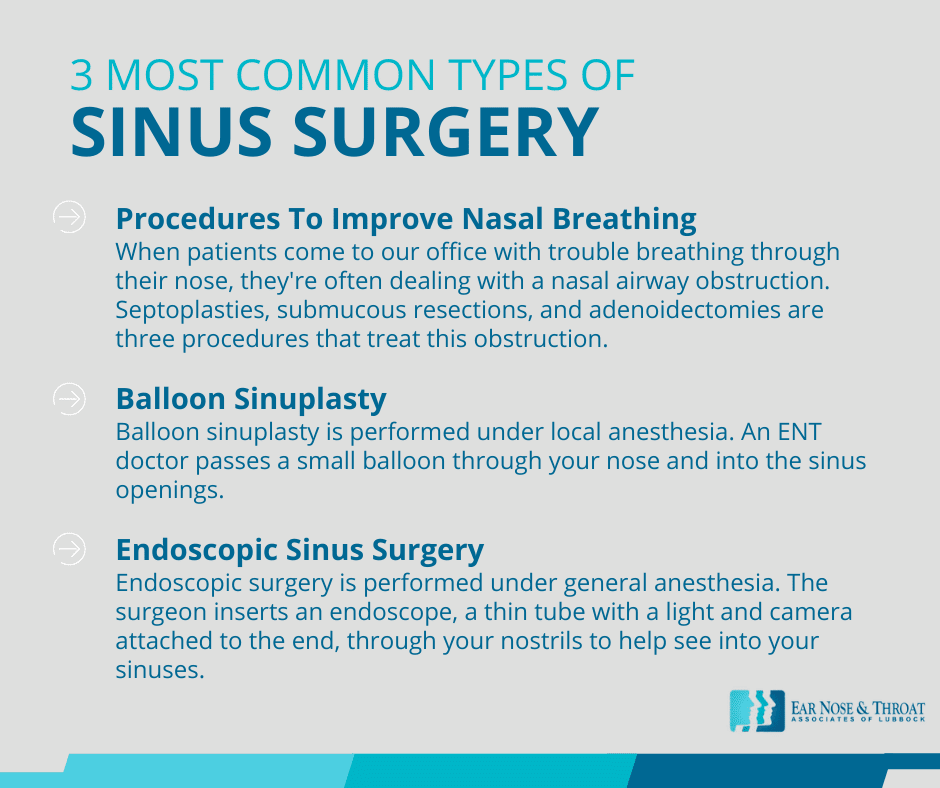3 Types of Sinus Surgery (and Which Is Right for You)

People undergo sinus surgery for a wide variety of reasons, such as to help prevent or treat infection, sleep apnea, or other serious health conditions. In our ENT practice, the number one reason for the sinus surgeries we perform is to improve the symptoms of chronic sinusitis.
What Is Chronic Sinusitis?
Chronic sinusitis occurs when the sinuses remain swollen for an extended period of time, usually several months. Your sinuses are air-filled spaces inside your head. Sinus tissue can become inflamed for a number of reasons, such as bacterial or viral infections, environmental allergies, and nasal polyps.
Symptoms of chronic sinusitis vary widely, but are similar to most upper respiratory illnesses: runny nose, congestion, facial pain and tenderness, headache and postnasal drainage.
Chronic sinusitis is, in a word, miserable. In fact, in one study participants with chronic sinusitis scored higher on a depression screener than participants without sinusitis.
With all this distress, it’s no wonder that many patients find themselves considering sinus surgery!

Three Types of Sinus Surgery
There are three main types of sinus surgery. Here are a few details about each of them, from the simpler procedures to the more involved.
1. Procedures To Improve Nasal Breathing
When patients come to our office with trouble breathing through their nose, they’re often dealing with a nasal airway obstruction. So the first category of sinus surgeries we’ll look at are procedures that improve your ability to breathe through your nose.
- Septoplasty. The nasal septum is the flat wall of bone and cartilage that separates the nose into two halves. Most people have a fairly straight septum, but it sometimes deviates to one side or the other. This is called a deviated septum. A deviated septum can cause difficulty breathing through one side of the nose, leading to snoring and congestion.
Septoplasty can be performed under local or general anesthesia. A small incision is made inside the nose to allow the surgeon to straighten the septum, improving nasal airflow without needing to remove much bone or cartilage. - Submucous resection of the inferior turbinates. Turbinates are small, bony ridges in the nose covered by soft tissue. They clean and moisturize air as it enters the nose and passes into the lungs. Sometimes, the inferior turbinates can enlarge and cause difficulty breathing through the nose.
A submucous resection decreases the size of the enlarged inferior turbinates to allow air to flow more freely.
Turbinate resection is often performed at the same time as septoplasty. - Adenoidectomy. Adenoids are small masses of lymph tissue at the back of the nose. Adenoids, also sometimes called pharyngeal tonsils, are an important part of the immune system in young children, helping to fight infection. Adenoids shrink as children grow older and their bodies develop other ways of fighting infection. Adenoid tissue usually disappears before the teen years.
Even though adenoids play an important role in the immune system, they can also become swollen and restrict nasal airflow. Adenoidectomies are performed under general anesthesia, so the patient is asleep during the entire procedure. The adenoids are removed through the mouth.
Tonsillectomies are frequently performed at the same time as adenoidectomies in young children. In adult tonsillectomies, the surgeon will remove any adenoid tissue that still remains.
2. Balloon Sinuplasty
Many chronic sinusitis patients suffer from chronic environmental allergies. But some also have small sinus openings, which means a small amount of swelling can have a bigger effect than usual.
If this is your specific issue, balloon sinuplasty may be the answer.
Balloon sinuplasty is performed under local anesthesia. An ENT doctor passes a small balloon through your nose and into the sinus openings.
The balloon is inflated for about 10 seconds and then removed. This brief inflation is enough to permanently widen the opening to the sinus cavity, allowing air to flow more freely.
3. Endoscopic Sinus Surgery
The last type of sinus surgery we’ll discuss is endoscopic sinus surgery. This is a much more invasive surgery for people with advanced infection, severe nasal polyps, or other tumors.
Endoscopic surgery is performed under general anesthesia. The surgeon inserts an endoscope (a thin tube with a light and camera attached to the end) through your nostrils to see into your sinuses.
The surgeon uses specialized instruments to safely remove any large blockages, including bone, tissue, tumors and polyps. This creates a much wider opening for air to flow into the sinuses.
Your Next Steps if You Suffer From Chronic Sinusitis
Occasional sinus blockage is a part of life for most people. Cold viruses will always be around to cause swelling and a stuffy nose. But if your nasal and sinus tissues have been inflamed for several months, it may be time to call in reinforcements.
Your first step is getting checked out by a trained ENT specialist. Dr. Philip Scolaro and Dr. David Cuthbertson are experienced in diagnosing and treating a variety of sinus issues. They are both skilled sinus surgeons as well, with experience performing all of the above procedures, and more.
Our team is here for you and your entire family. Call our office today to schedule a consultation. We look forward to meeting you!
Dr. Scolaro is a board-certified Otolaryngologist servicing the South Plains area. He has been practicing in Lubbock since 1990 and has earned a reputation as a skilled and experienced surgeon. He currently serves as the Medical Director for Covenant High Plains Surgery Center campuses, is a member of Covenant Health Partners and is an adjunct faculty professor for Texas Tech University Health Sciences Center School of Medicine. Learn more about Dr. Scolaro.
Categories:








